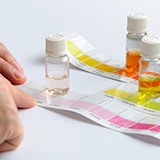
How to Measure the Quality of Water
Did you know there are 267 different contaminants1 in American tap water? Everything from minerals to carcinogens, to antibiotics!
Previously, we covered the basics of where your water comes from and how to read a municipal water report. We also looked at common water contaminants. Now, we'll explore how to measure the quality of water in your home. Testing water quality is crucial to figuring out how to eventually clean up your water.
How to Test Water Quality
 If you get your water from a private well instead of a municipal system, you will not receive a water quality report from the government. Even if you do get municipal water, your home's water quality may differ depending on the contaminants in your piping and other factors.
If you get your water from a private well instead of a municipal system, you will not receive a water quality report from the government. Even if you do get municipal water, your home's water quality may differ depending on the contaminants in your piping and other factors.
Under these circumstances, it's your responsibility to test your home's water for harmful contaminants. There are a variety of low-cost kits you can purchase to test your water quality at home. They include at-home water test strips that change color in the presence of certain contaminants.
For example, some water testing strips measure pH, or how acidic a liquid is. A pH level of 7 represents neutral water. Any number lower than 7 indicates acidity, which can mean the presence of certain contaminants. A pH that is higher than 7 indicates alkaline water, which some experts believe has health benefits.
Other home water tests kits can measure hardness, iron, copper, lead, nitrate, chlorine, and more. Some can even detect bacteria such as e. coli. However, these tests aren't always accurate, and they won't tell you how much of a contaminant is present. They are an inexpensive way to figure out if you have a problem.
If your water tests positive for any of these contaminants, you may consider hiring a certified laboratory to conduct a detailed analysis of your water. For well water testing, you should hire a lab from the start to be safe. These professionals will provide an accurate, detailed report of what's in your water, although they are much more expensive than home test kits.
Once you've identified what's in your water, you can decide what to do about it. If your water is clean, good for you! If not, it's time to start considering water filtration options.
Have questions about your water? Please contact us for help figuring out your next steps.
![]() NEXT: Shop All Water Filtration
NEXT: Shop All Water Filtration
1. According to the Environmental Working Group

